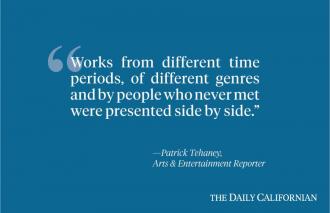Attempting a complete look at the art of the Bay Area over the past 200 years and before is no small feat. It has to cut across generations, mediums and themes in order to present a cohesive summary of artistic activity from and inspired by the Bay Area.
From June 13 to September 2, the Berkeley Art Museum and Pacific Film Archive, or BAMPFA, will display the second part of its ongoing, multifaceted exhibition “Way Bay,” organized by director and chief curator Lawrence Rinder, film curator Kathy Geritz and engagement associate David Wilson.
Works from different time periods, of different genres and by people who never met were presented side by side. Additionally, all media were considered and included — drawings, paintings, sculptures, photographs, films, prints, collages, fiber works and more. The exhibition focused on width of coverage, with only one piece displayed per artist for most of the exhibit. However, the links among disparate artworks succeeded to create thematic vignettes.
More than 100 artists were recognized, from heavyweight abstract expressionist Richard Diebenkorn to Martin Wong, the subject of a recent BAMPFA exhibition, to contemporary artist Tali Weinberg. Small objects worked to contrast or supplement larger objects in the exhibition.
The gallery was divided into sections each titled with an excerpt of a poem by a Bay Area author. Through this playful feature of organization, poetry was also included in the forms of art represented. The groupings celebrated basic questions that art has repeatedly raised — nature, community, revolution — instead of the usual chronological development that exhibits tend to present.
Many of the exhibition walls became clever collages on a single method of representation or concept — whether geographic, social, cultural or representational. One of the early walls, titled “Each exhalation, the birth of another century, its violent form,” after Aja Couchois Duncan, from “Class,” combines photography of the Ferguson protests, an acrylic painting in protest of white rhino poaching and reproductions of FBI files. Each of these works, representing different social revolutions, showed the evolving tools of protest.
The section titles ranged from describing the physical qualities of the artworks to their conceptual intentions. “When the brightening came, only the darkest survived” from Namwali Serpell’s “Company” focused on the use of light, contrast and the extreme visual qualities of black and white.
Weinberg’s and Nick Makanna’s works were shown side by side in a grouping titled “She dances the city back into balance, every weekend she dances for the city.” The line of poetry was taken from Kim Shuck’s 2015 “Unhomed.” The group featured sculptures, paintings, prints and a video installation. Each work presented an array of pattern, line and color. Abstract geometric paintings hinted at the geometry of real objects. The film, Jordan Belson’s 1952 “Bop Scotch” was a frantic stop-motion animation of San Francisco pavements, tiles and manhole covers set to an energetic jazz soundtrack.
The ambiguity of each grouping worked to the advantage of the art. It allowed the curators of the exhibit to show their skill in placing and arranging art on the walls of the gallery, forming pleasing arrangements. It also carved connections among previously disparate works. The flashing images of “Bop Scotch” evoked the geometric patterns of “Carrots” by Evelyn Reyes and “Thought patterns: To pay attention is a political act” by Weinberg, whose printed text linked the formal patterns to a deeper political meaning.
The exhibit was a wonderful encyclopedia of both the history of visual art in the Bay Area and the works of currently practicing artists. Though brief on the specific context of most individual pieces, the showing formed a subtle narrative about the role of the Bay Area as teacher, community and resource.
In our information-soaked age, this exhibit provided hundreds of leaping-off points for further discovery and experience. Though it is hard to discern a particular critical reading of Bay Area art, the exhibit succeeds as a magnificent collection of objects.
Contact Patrick Tehaney at ptehaney@dailycal.org. Tweet him at @patricktehaney.
